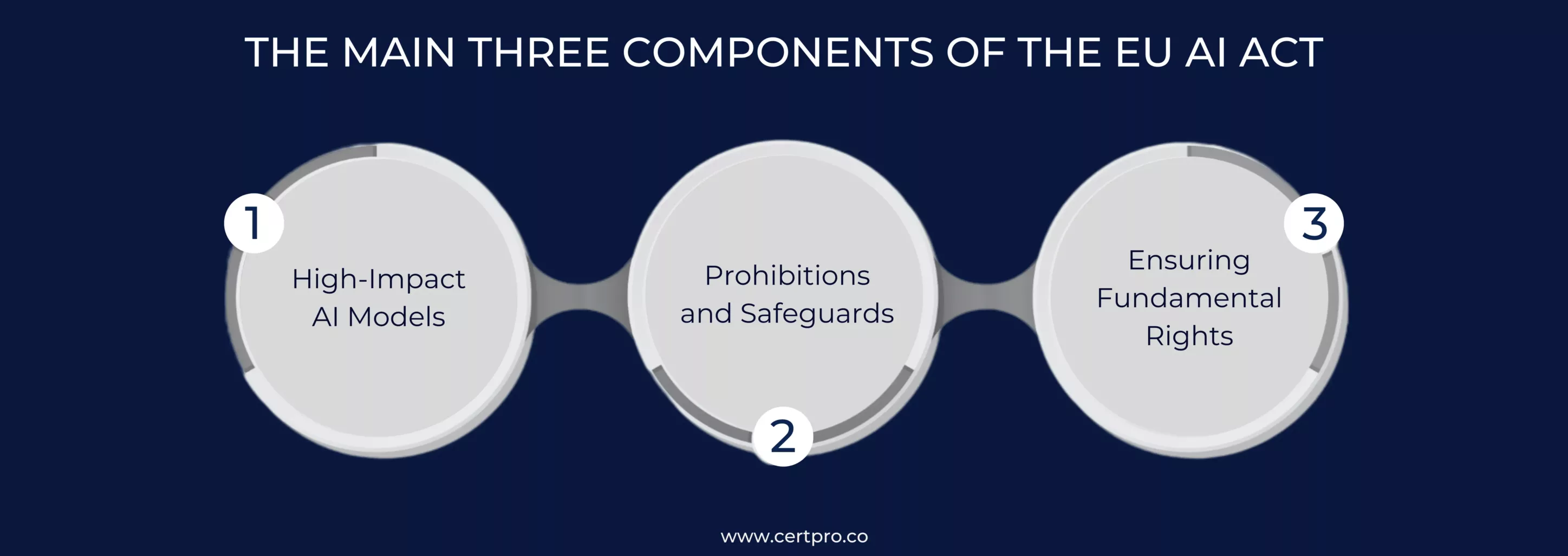Nowadays, Artificial Intelligence (AI) is transforming our lives exceptionally well. AI is now streamlining healthcare services, providing virtual assistance, and fulfilling queries. Technologies have boons and curses. Similarly, AI creates many concerns about violating fundamental rights and freedom. Therefore, the European Union has developed measures to monitor AI. The act aims to promote human-centric and trustworthy AI while ensuring safety and environmental protection. Similarly, the act boosts the innovation and development of secure and ethical AI technology. The European Union is willing to become the leader in developing safe and ethical AI development.
This article delves into a brief discussion about the EU AI Act and its role in securing data privacy in the future. In a few days, different countries will develop their own open laws regarding AI monitoring to ensure their client’s data and rights.
THE EU AI ACT
The EU AI Act is the world’s first concrete initiative for regulating and controlling AI. The ACT ensures that the EU monitors the use of AI in industries and assures customer safety. Furthermore, the main objective is to foster investment and innovation in AI. AI has a powerful impact on the financial sector. Therefore, the Europe Artificial Intelligence Act contains a three-tier risk classification model. It helps categorize risk based on its effects on fundamental rights and user protection. The financial sector is based on data-driven processes that will ultimately depend on AI in the near future. In economic sectors, AI systems are used for credit assessment and evaluation of risks for premium customers. Furthermore, using AI systems in financial industries falls under high risk. In addition, AI is used for biometric identification and monitoring of the employee management process.
The EU AI Act defines AI systems based on their potential risks and ensures that the AI technologies placed on the European market adhere to safety standards for their clients. The main three components of the ACT are described below:
1. High-Impact AI Models: The EU AI Act covers the general-purpose AI models that pose potential risks. Misuse of such systems can have extensive consequences. In addition, the ACT revises the AI governance process and ensures effective oversight and accountability.
2. Prohibitions and Safeguards: The ACT lists prohibitions and addresses concerns related to AI deployment. The main priority is to balance security and privacy when using AI-based systems.
3. Ensuring Fundamental Rights: A fundamental rights assessment is required before using high-risk AI systems. It helps identify potential privacy risks and fundamental rights.

UNDERSTANDING THE ACT
The ACT monitors AI practice, fosters innovation, and safeguards fundamental rights.
Comprehending the Current Status: In the initial step, the organization should assess the status of its AI systems, or the company should plan to procure AI systems from third-party providers or model repository AI systems. The European Union AI Act is the organization’s requirement to implement to ensure its security. Even if the organization is not using AI, it can start using its existing software. If that is not available, then business units can perform the survey for the EU AI Act.
Risk Classification: AI systems can be classified based on risk. The EU AI Act distinguishes different risk categories, including systems that pose an unacceptable risk. Therefore, systems falling into this category are prohibited. For example, real-time remote biometric identification in public places increases data vulnerabilities. High-risk systems are permitted, but complying with the security requirements is essential. The producer should complete this assessment before marketing and registering the systems in an EU database. Effective risk management is required for high-risk AI systems to operate.
The organization must follow robust governance and training programs to ensure cyber security. For example, high-risk systems contain information regarding critical infrastructure or systems used in hiring, credit scoring, or insurance claims. In addition, transparency is mandatory for limited-risk systems. The users must have been informed that they were chatting with chatbots. It is crucial to implement a code of conduct for all AI systems.
Planning for Execution: If you are a provider, deployer, importer, or distributor of AI systems, you must confirm that your AI practices align. Therefore, you need to assess the risks associated with your AI systems. Then, create awareness and design ethical systems. You need to assign the respective jobs and establish formal governance for the whole system. Hence, these proactive measures can prevent the risk of data breaches related to AI systems. The process requires 6 months to adhere to the requirements, 12 months to meet specific general-purpose AI requirements, and 24 months to complete compliance.
PENALTIES FOR NON-COMPLIANCE
Non-compliance with the European Union AI Act can negatively impact service providers. The approximate range of penalties is from €7.5 million to €35 million. On the other hand, the company must pay 1% to 7% of annual turnover as a penalty. It considers the severity of the violation and which penalties are applicable. Therefore, the organization must ensure compliance with the provisions.
SCOPE OF APPLICATION
The EU AI Act applies to service providers, distributors, manufacturers, and deployers of AI systems. Like other EU regulations in the digital context, it has a broad territorial scope. The EU AI Act covers companies working in the European market or handling data from the European region. It also covers third-country providers related to the EU. The ACT follows a risk-based approach. Furthermore, AI systems that violate fundamental rights are strictly prohibited. For example, AI-based systems help classify individuals based on their social behavior or characteristics.
The EU AI Act created a comprehensive framework for high-risk systems, including those intended for critical infrastructure or juridical processes. Again, it is essential to register the high-risk system in the EU Commission database. These systems require extensive compliance mechanisms regarding risk management, data governance, and record-keeping processes. General-purpose AI models have separate criteria. Therefore, a GPAI model can perform various tasks and be integrated into multiple systems. The model requires proper technical documentation and makes the system available for competent testing. If the GPAI models develop systemic risks, the providers must notify the EU Commission immediately.
If AI-generated systems interact with humans, the providers, deployers, or manufacturers must inform the users that they are interacting with an AI system. Therefore, users’ emotion recognition systems or biometric categorization systems must inform the clients regarding their interaction with AI systems.
FINAL THOUGHTS
AI regulations are becoming inevitable with technological advancements. Therefore, the organization should stay informed regarding AI’s rules and ethical practices. In this respect, collaboration with industry peers can help you implement responsible AI practices in your organization. The monitoring process for AI helps unlock the technology’s potential capabilities while safeguarding human fundamental rights.
FAQ
What is the most significant risk of using AI-based systems?
Using AI can cause privacy violations, algorithmic bias, inequalities, and unauthorized access to data. Therefore, AI surveillance acts can minimize the risk and improve the services.
Who will enforce the EU AI Act?
If your organization has an AI-based system and manages data from the European Union or performs business in the EU, you must comply with the act.
Has the EU AI Act passed?
The act was passed on 13th March 2024 by the European Parliament. It is the first comprehensive attempt to regulate artificial intelligence.
What are the advantages of the EU AI Act?
The AI Act aims to ensure that AI systems in the EU are safe and respect fundamental rights. It also fosters investment and innovation in AI and enhances governance.
What is ‘systemic risk’ in the EU AI Act?
Systemic risk is considered the potential of AI systems. Thus, it creates the presumption of risk wherever a large-scale GPAI operates.

About the Author
Tamali Ghosh
Tamali Ghosh is a seasoned creative content writing professional specializing in SOC 2, GDPR compliance, and ISO 42001. Her in-depth knowledge of cyber security and skillful writing capabilities make complex topics straightforward. Additionally, her writing helps the reader understand the rules and regulations in cyber security and information security practice.
HOW DOES THE NIST CYBERSECURITY FRAMEWORK FUNCTION, AND WHY IS IT IMPORTANT?
Emerging cyber threats make cybersecurity an essential consideration for organizations handling and managing data. In this regard, the NIST cybersecurity framework applies to improving your cybersecurity program. It is a set of guidelines that helps improve your...
UNDERSTANDING ISO 42001: A GUIDE FOR RESPONSIBLE AI MANAGEMENT SYSTEMS
The invention of artificial intelligence (AI) has changed the operational processes of many industries. However, the rapid growth of technology increases ethical, security, and privacy-related concerns. Therefore, the International Organization for Standardization...
How to Implement GRC Frameworks in 2024: Step-by-Step Guide
The rapidly evolving business environment, complexity, and accountability enhance the importance of the organization's governance, risk management, and compliance initiatives. Therefore, if your company finds difficulties expanding, recheck your organization's...




